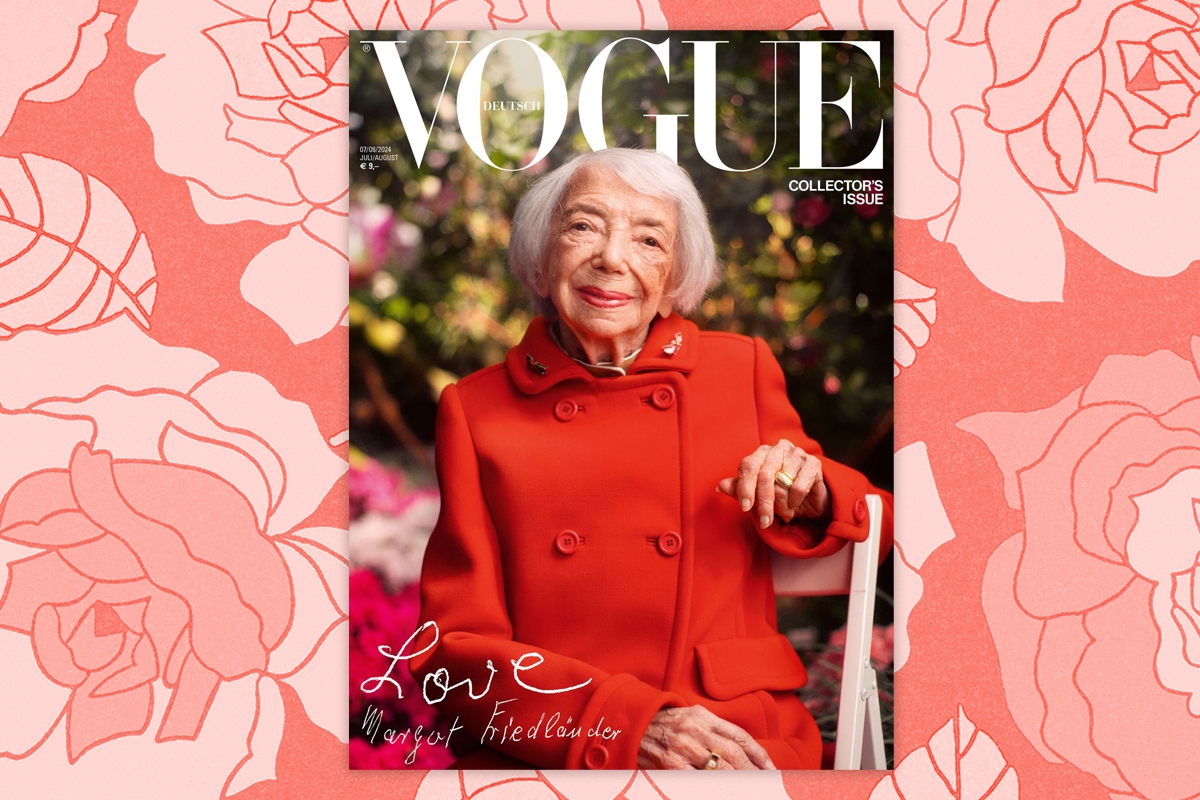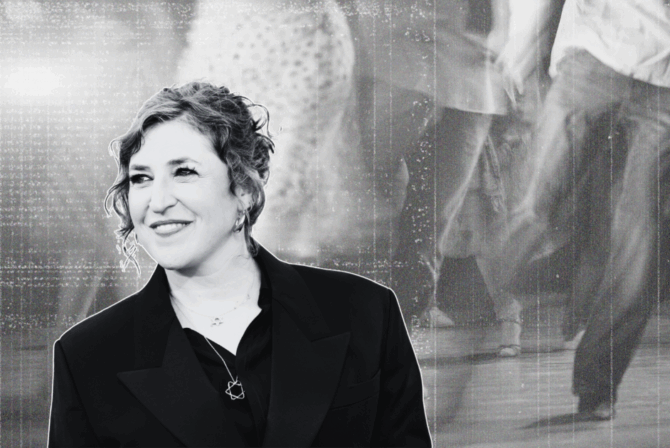Congratulations to Margot Friedländer, Holocaust survivor, centenarian, writer and newly minted Vogue cover girl. The 102-year-old will grace the cover of the July/August edition of German Vogue, sharing with writer Miriam Amro, who met with her over the course of a few months for the story, a timely and timeless message: “Don’t look at what divides you. Look at what unites you. Be human, be reasonable.”
Friedländer, the only member of her family to survive the camps, was photographed at the Botanical Gardens of the Free University of Berlin. The cover image features her smiling brightly with lips painted a shiny red, wearing a tailored peacoat adorned by pins and a thick gold ring on her ring finger. Her eyes exude warmth and kindness as she looks at the camera, and the word “love,” along with her name, are signed at the bottom of that cover image.
Friedländer was a 12-year-old girl living in Berlin when Hitler rose to power. She had an almost idyllic youth in a middle class family in Berlin. Her family owned a button factory that supplied wares to Jewish fashion houses in the city’s Mitte. She dreamed of working in the fashion industry, training as a fashion illustrator and seamstress — a dream that was dashed as the Nazis came to power. As the Nazi regime began to limit the freedoms of Jewish citizens, her mother wanted to leave the country, but her father, a World War I veteran, didn’t want to abandon his homeland.
Kristallnacht was what finally broke her and her family’s illusion of safety. Margot’s mother, Auguste, tried all she could to get her, Margot and her brother, Ralph, a way out of Germany, attempting to get visas from different embassies to help them escape, including the U.S. embassy, which refused them. It’s something that Margot said she could never quite forgive America for, despite the country becoming her home in 1946.
In 1943, Ralph, 17, was captured and taken away from their home by the Gestapo. Auguste, not wanting him to be alone, went to find him. She left Margot some prized possessions: an amber necklace that she wears to this day, and a message with the neighbors, one that stayed with her for the rest of her years — “try to make your life.” Those words also became the title of her autobiography. Margot didn’t know where her family members were going, though there were rumors of Jews being deported to “the east.” She eventually discovered that both Auguste and Ralph were murdered in Auschwitz.
Fellow Berliners helped Margot hide. She wore a cross, dyed her hair and surgically changed her nose to appear less Jewish. She moved from place to place, yet she was eventually caught by the SS after being discovered by Jewish “graspers” who were forced by the Nazis to track down other Jews. She was sent to Theresienstadt. It was there that she found Adolf Friedländer, a man she had met before at the Jewish Cultural Association in Berlin, where she worked as a costume dressmaker. It was their joint interests and shared suffering that brought them together, and they were eventually married by a rabbi in that very camp. Margot, of course, sewed her own dress.
After the war, they two moved to America and wound up in Kew Gardens, Queens, speaking German with each other but never quite sharing their stories, and never stepping back in the country and city of their birth together. She worked as a seamstress and travel agent, and traveled the world. They never had children. When Adolf died in 1997, after over 50 years of marriage, Margot started sharing her story, and a writing class at the 92Y helped her pen her memoir. Later, in 2003, she visited Berlin again for the first time. And at age 89, she moved back to Germany, telling her story over and over again to younger generations.
“I’m happy, every day, every hour, that I came back,” she told Berliner Zeitung’s Susanne Lenz in 2021. “I don’t hate Germans,” she says. “I am German. I belong here, I have nothing to forgive.”
She has received many awards and accolades, including the Order of Merit of the Federal Republic of Germany and an honorary doctorate from the Free University of Berlin. Last year, she even got to meet Jewish first gentleman Doug Emhoff (she was thrilled when Biden was elected in 2020). But her greatest prize and honor has been the ability to share her story with young people, who send her letters of gratitude. She shared with Lenz a letter sent to her by a young girl. “I admire you,” the girl wrote. “We learned about that time in our history lessons, but when you came, it was something completely different. I really understood it then.”
Margot still feels that she lives for her mother and her brother. She had a Stolpersteine — a golden remembrance brick — laid for them where they last lived, and she puts stones on the graves of her grandmother at the Jewish cemetery where she is buried in their honor. And she tries to pass on a legacy of tolerance and humanity to younger generations in their honor.
“We are all equal. There is no Christian blood, no Muslim blood, no Jewish blood. There is only human blood. Everything is the same,” she shared with the EU on Holocaust Remembrance Day in 2022.
Margot remains “proud to be Jewish.” She knows that antisemitism will always be there, and she is horrified by the rise of antisemitism in modern times, yet she remains hopeful and not bitter, according to Amro. And now, she’s getting to share her unwavering love of fashion with readers across the world, in a spread of images where she dons stylish garb, surrounded by beautiful flowers and wearing her mother’s necklace in the most vaunted fashion magazine in the world. Along with all that glamour, she’s also sharing her story and her hope that people never forget history and never forget to see each other’s humanity.
“You will carry my story onward. That this never comes to happen again,” she shared.








